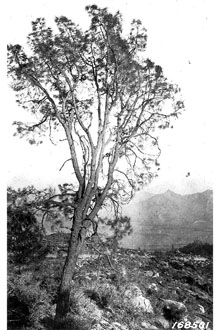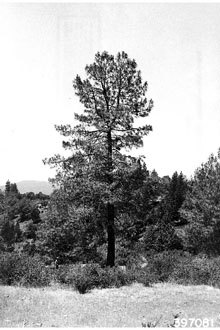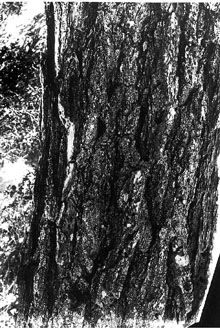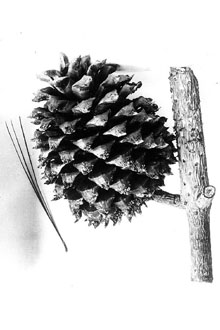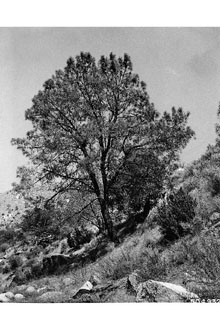California Foothill Pine
Scientific Name: Pinus sabiniana Douglas ex Douglas
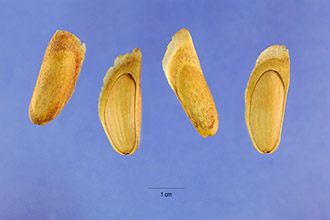
| General Information | |
|---|---|
| Usda Symbol | PISA2 |
| Group | Gymnosperm |
| Life Cycle | Perennial |
| Growth Habits | Tree |
| Native Locations | PISA2 |
Plant Guide
Alternative Names
foothill pine, bull pine, digger pine, California foothill pine , Use soil moisture sensors to measure the soil moisture of California Foothill Pine.
Uses
Ethnobotanic: The seeds of gray pine were eaten by many California Indian tribes and are still served in Native American homes today. They can be eaten fresh and whole in the raw state, roasted, or pounded into flour and mixed with other types of seeds. The seeds were eaten by the Pomo, Sierra Miwok, Western Mono, Wappo, Salinan, Southern Maidu, Lassik, Costanoan, and Kato, among others. Sierra Miwok men climbed the trees and twisted the green cones off by hand before the seeds were fully developed. These immature cones were roasted for 20 minutes in hot ashes, yielding a brown, sweet syrup. The pitch of the gray pine was used as a medicine by the Western Mono and the branches were made into household utensils for stirring acorn mush. The Costanoan used the pitch as a treatment for rheumatism. The needles were used for thatch, bedding, and floor covering and the bark for house covering by the Sierra Miwok. The branches and roots were used in California Indian basketry and still gathered to a limited extent by contemporary weavers. Wildlife: Numerous birds feed on the seeds of gray pine including the red-shafted flicker, California jay, and band-tailed pigeon. The foliage, bark, and seeds provide food for black bears, Douglas chickarees, and gray squirrels. Mule and white-tailed deer browse the foliage and twigs.
Status
Please consult the PLANTS Web site and your State Department of Natural Resources for this plant’s current status, such as, state noxious status, and wetland indicator values.
Description
General: Pine Family (Pinaceae). This native tree reaches 38 m in height with a trunk less than 2 m wide. The gray-green foliage is sparse and it has three needles per bundle. Each needle reaches 9-38 cm in length. The trunk often grows in a crooked fashion and is deeply grooved when mature. The seed cone of gray pine is pendent, 10-28 cm, and opens slowly during the second season, dispersing winged seeds.
Distribution
It ranges in parts of the California Floristic Province, the western Great Basin and western deserts. For current distribution, please consult the Plant Profile page for this species on the PLANTS Web site.
Establishment
Adaptation: This tree is found in the foothill woodland, northern oak woodland, chaparral, mixed conifer forests and hardwood forests from 150-1500m. Extract seeds from the cones and gently rub the wings off, and soak them in water for 48 hours, drain them, and thoroughly surface-dry. Put seeds in a plastic bag, without any medium, seal the bag and place them in refrigerated conditions until their Plant Materials <http://plant-materials.nrcs.usda.gov/> Plant Fact Sheet/Guide Coordination Page <http://plant-materials.nrcs.usda.gov/intranet/pfs.html> National Plant Data Center <http://npdc.usda.gov>
Management
The Pomo pruned the trees periodically. Cultivars, Improved and Selected Materials (and area of origin) This species is available from most nurseries within its range that handle native plants. Contact your local Natural Resources Conservation Service (formerly Soil Conservation Service) office for more information. Look in the phone book under ”United States Government.” The Natural Resources Conservation Service will be listed under the subheading “Department of Agriculture.”
References
Barrett, S.A. & E.W. Gifford 1933. Miwok material culture. Bulletin of the Public Museum of the City of Milwaukee 2(4):117-376. Beard, Y.S. 1979. The Wappo A Report. Malki Museum Press. Morongo Indian Reservation, Banning, California. Bocek, B.R. 1984. Ethnobotany of Costanoan Indians, California, based on collections by John P. Harrington. Economic Botany 38(2):240-255. CalPhotos 2000. Pinus sabiniana. <http://elib.cs.berkeley.edu/cgi/img_query?seq_num =16975&one=T>. Version: 000229. CalFlora, Inc., Berkeley, California. Essene, F. 1942. Culture element distributions: XXI Round Valley. Anthropological Records 8(1):1-97. Goode, R.W. 1992. Cultural traditions endangered. Unpublished report. Goodrich, J., C. Lawson, & V. P. Lawson Kashaya Pomo plants. American Indian Studies Center. University of California, Los Angeles, California. Griffin, J.R. 1993. Pinus. Pages 117-120 IN: The Jepson manual: Higher plants of California. J.C. Hickman (ed.). University of California Press, Berkeley, California. Littlejohn, H.W. 1928. Nisenan geography. Unpublished manuscript in the Bancroft Library, University of California, Berkeley, California. Martin, A.C., H.S. Zim, & A.L. Nelson 1951. American wildlife and plants: A guide to wildlife food habits. Dover Publications, New York, New York. Peri, D.W., S.M. Patterson, & J.L. Goodrich 1982. Ethnobotanical mitigation Warm Springs Dam-Lake Sonoma California. Unpublished report prepared for the U.S. Army Corps of Engineers, San Francisco District, San Francisco, California. USDA, NRCS 2000. The PLANTS database. <http://plants.usda.gov>. Version: 000229. National Plant Data Center, Baton Rouge, Louisiana.
Plant Traits
Growth Requirements
| Temperature, Minimum (°F) | 12 |
|---|---|
| Adapted to Coarse Textured Soils | Yes |
| Adapted to Fine Textured Soils | No |
| Adapted to Medium Textured Soils | Yes |
| Anaerobic Tolerance | None |
| CaCO3 Tolerance | Medium |
| Cold Stratification Required | Yes |
| Drought Tolerance | High |
| Fertility Requirement | Low |
| Fire Tolerance | Low |
| Frost Free Days, Minimum | 230 |
| Hedge Tolerance | Low |
| Moisture Use | Low |
| pH, Maximum | 8.3 |
| pH, Minimum | 6.0 |
| Planting Density per Acre, Maxim | 1200 |
| Planting Density per Acre, Minim | 430 |
| Precipitation, Maximum | 24 |
| Precipitation, Minimum | 14 |
| Root Depth, Minimum (inches) | 40 |
| Salinity Tolerance | None |
| Shade Tolerance | Intolerant |
Morphology/Physiology
| Bloat | None |
|---|---|
| Toxicity | None |
| Resprout Ability | No |
| Shape and Orientation | Erect |
| Active Growth Period | Spring and Summer |
| C:N Ratio | High |
| Coppice Potential | No |
| Fall Conspicuous | No |
| Fire Resistant | No |
| Flower Color | Yellow |
| Flower Conspicuous | No |
| Foliage Color | Green |
| Foliage Porosity Summer | Dense |
| Foliage Porosity Winter | Dense |
| Foliage Texture | Medium |
| Fruit/Seed Conspicuous | No |
| Nitrogen Fixation | None |
| Low Growing Grass | No |
| Lifespan | Moderate |
| Leaf Retention | Yes |
| Known Allelopath | No |
| Height, Mature (feet) | 80.0 |
| Height at 20 Years, Maximum (fee | 20 |
| Growth Rate | Slow |
| Growth Form | Single Stem |
| Fruit/Seed Color | Brown |
Reproduction
| Vegetative Spread Rate | None |
|---|---|
| Small Grain | No |
| Seedling Vigor | Medium |
| Seed Spread Rate | Slow |
| Seed per Pound | 580 |
| Fruit/Seed Persistence | No |
| Propagated by Tubers | No |
| Propagated by Sprigs | No |
| Propagated by Sod | No |
| Propagated by Seed | Yes |
| Propagated by Corm | No |
| Propagated by Cuttings | No |
| Bloom Period | Early Spring |
| Commercial Availability | Contracting Only |
| Fruit/Seed Abundance | High |
| Fruit/Seed Period Begin | Summer |
| Fruit/Seed Period End | Fall |
| Propagated by Bare Root | Yes |
| Propagated by Bulb | No |
| Propagated by Container | Yes |
Suitability/Use
| Veneer Product | No |
|---|---|
| Pulpwood Product | No |
| Protein Potential | Low |
| Post Product | No |
| Palatable Human | Yes |
| Palatable Graze Animal | Low |
| Palatable Browse Animal | Low |
| Nursery Stock Product | Yes |
| Naval Store Product | No |
| Lumber Product | No |
| Fuelwood Product | Medium |
| Fodder Product | No |
| Christmas Tree Product | No |
| Berry/Nut/Seed Product | No |

